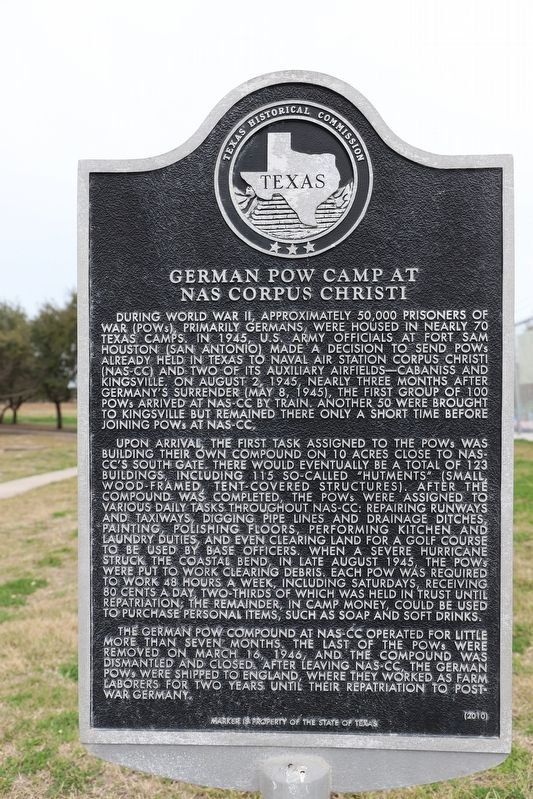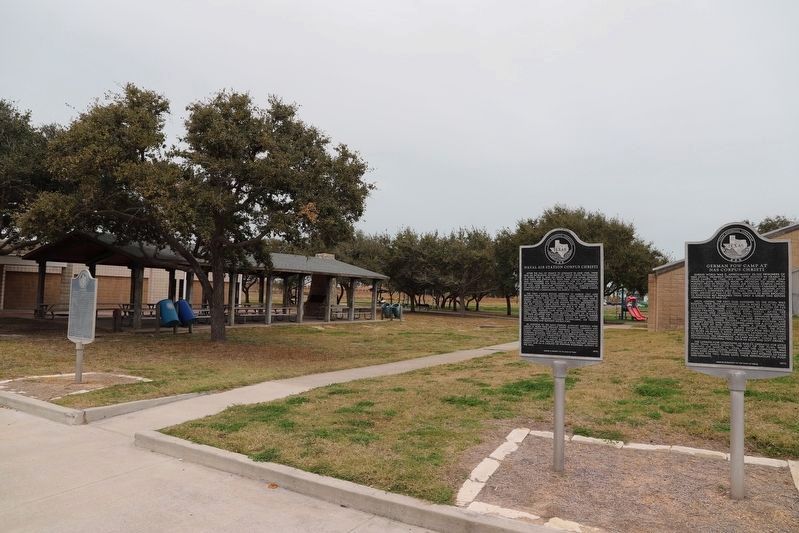Corpus Christi in Nueces County, Texas — The American South (West South Central)
German POW Camp at NAS Corpus Christi
During World War II, approximately 50,000 prisoners of war (POWs), primarily Germans, were housed in nearly 70 Texas camps. In 1945, U.S. Army officials at Fort Sam Houston (San Antonio) made a decision to send POWs already held in Texas to Naval Air Station Corpus Christi (NAS-CC) and two of its auxiliary airfields-Cabaniss and Kingsville. On August 2, 1945, nearly three months after Germany’s surrender (May 8, 1945), the first group of 100 POWs arrived at NAS-CC by train. Another 50 were brought to Kingsville but remained there only a short time before joining POWs at NAS-CC.
Upon arrival, the first task assigned to the POWs was building their own compound on 10 acres close to NAS-CC’s south gate. There would eventually be a total of 123 buildings, including 115 so-called ”Hutments” (small, wood-framed, tent-covered structures). After the compound was completed, the POWs were assigned to various daily tasks throughout NAS-CC: repairing runways and taxiways, digging pipe lines and drainage ditches, painting, polishing floors, performing kitchen and laundry duties, and even clearing land for a golf course to be used by base officers. When a severe hurricane struck the coastal bend, in late August 1945, the POWs were put to work clearing debris. Each POW was required to work 48 hours a week, including Saturdays, receiving 80 cents a day, two-thirds of which was held in trust until repatriation; the remainder, in camp money, could be used to purchase personal items, such as soap and soft drinks.
The German POW compound at NAS-CC operated for little more than seven months. The last of the POWs were removed on March 16, 1946, and the compound was dismantled and closed. After leaving NAS-CC, the German POWs were shipped to England, where they worked as farm laborers for two years until their repatriation to post-war Germany.
Erected 2010 by Texas Historical Commission. (Marker Number 16479.)
Topics. This historical marker is listed in this topic list: War, World II. A significant historical date for this entry is August 2, 1945.
Location. 27° 39.786′ N, 97° 17.244′ W. Marker is in Corpus Christi, Texas, in Nueces County. Marker is on Graham Road, on the right when traveling north. Touch for map. Marker is at or near this postal address: 654 Graham Rd, Corpus Christi TX 78418, United States of America. Touch for directions.
Other nearby markers. At least 8 other markers are within 5 miles of this marker, measured as the crow flies. Naval Air Station Corpus Christi (here, next to this marker); Flour Bluff (a few steps from this marker); Duncan Cemetery (approx. 1.4 miles away); Flour Bluff Independent School District (approx. 1.4 miles away); Sunshine Cemetery (approx.
4.1 miles away); Ward Island (approx. 4.2 miles away); Karankawa Indians (approx. 4.4 miles away); Coastal Hide, Tallow and Packing Industries (approx. 4.8 miles away). Touch for a list and map of all markers in Corpus Christi.
Credits. This page was last revised on September 30, 2022. It was originally submitted on September 30, 2022, by Dave W of Co, Colorado. This page has been viewed 267 times since then and 51 times this year. Photos: 1, 2. submitted on September 30, 2022, by Dave W of Co, Colorado. • J. Makali Bruton was the editor who published this page.

